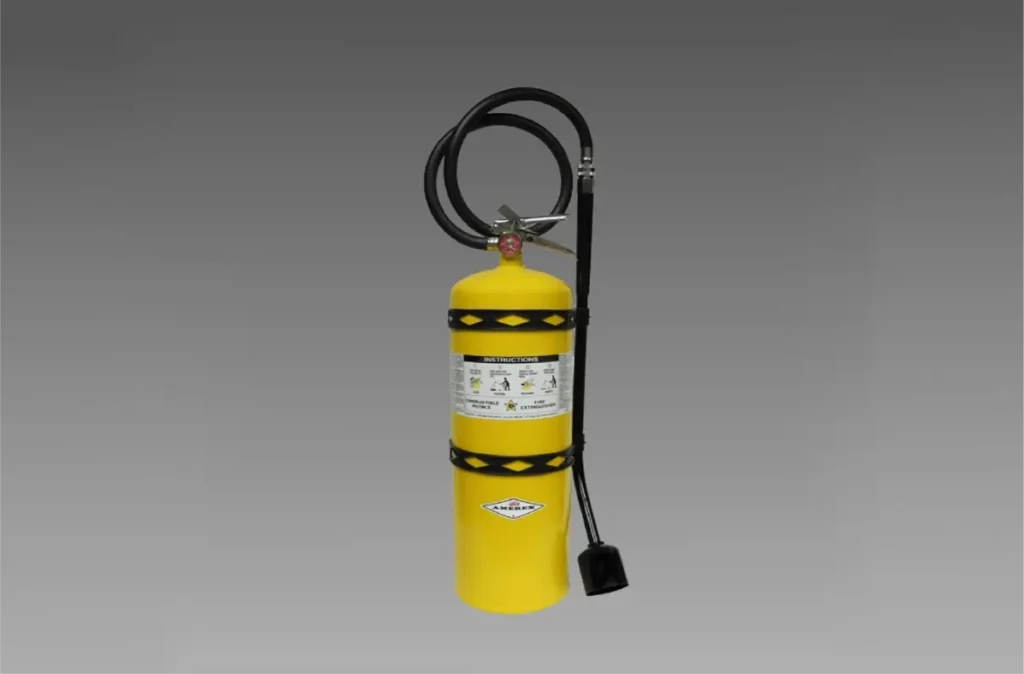
Class D Powder Fire Extinguishers
Discover Class D fire extinguishers designed for combustible metal fires. Learn about M28 and L2 powders, their applications, and how
Best for Classes of Fire: A, B
Aqueous Film Forming Foam (AFFF) Fire Extinguishers labeled in cream are widely used for Class B fires and are also effective for Class A fires due to their water-based foam agent, which helps in preventing re-ignition.:

When foam extinguishers pass di-electric testing, they become safe for use on electrical devices.
Foam extinguishers are a water-based type of extinguisher, containing obviously water with an additive called aqueous film forming foam, AFFF for short, which creates a film over the burning liquid or burning substance preventing oxygen getting to the fire and providing cooling power. It is a very versatile extinguisher. It is usually discharged as a spray rather than a jet, which also reduces the risk of electrocution. It does create a slimy residue behind it which can be problematic to clean up afterwards.
There are concerns as to the fluorocarbons in the AFFF and there are moves within the European Parliament to ban some of these substances known as PFA’s.
Legislation is going through European Parliament now. It’s liable to apply to fixed systems first and then long term to portable extinguishers. Having said that, manufacturers are already working on the substances used in the foam additive to try and remove PFAs from it to make it less of an environmental risk.
It is important to note that foam should never be discharged into a water course, because it can produce contamination of the water.
Contact us now to learn more about Foam Fire Extinguishers and how they can be an essential part of your fire safety plan.
Foam extinguishers work by creating a barrier between the flammable liquid and the oxygen in the air. The foam blanket suppresses the fire and prevents re-ignition.
Foam extinguishers are effective against Class A (ordinary combustibles) and Class B (flammable liquid) fires. They are not suitable for Class C (gas) fires, or fires involving electrical equipment.
The basic steps for using a foam extinguisher are:
Yes, foam extinguishers are suitable for outdoor use. They are effective in combating fires involving flammable liquids commonly found in outdoor settings.
Fire extinguishers, including foam extinguishers, should be inspected at least annually. They also require a more detailed maintenance check, typically every 5 years, depending on the type and guidelines provided by the manufacturer.
The effective range of a foam extinguisher is typically around 8-12 feet (2.4-3.7 meters). It’s important to stay within this range for optimal firefighting effectiveness.
Foam extinguishers can be used in freezing temperatures, but they must have low freeze additive included with the foam additive.
Cleaning up after using a foam extinguisher involves wiping away the residue with a damp cloth. The foam is water-based and generally non-toxic, but it’s essential to follow the manufacturer’s instructions for proper cleanup.
Foam extinguishers are suitable for kitchen fires involving ordinary combustibles (Class A) and flammable liquids (Class B). However, they may not be the best choice for cooking oil or fat fires, where a wet chemical extinguisher is often recommended.
Always follow the guidelines provided by the manufacturer and relevant safety regulations when using or maintaining foam fire extinguishers.
Don’t hesitate to reach out to us, or you can easily fill out the form below. We’re here to assist you.


Discover Class D fire extinguishers designed for combustible metal fires. Learn about M28 and L2 powders, their applications, and how

are designed for safely extinguishing cooking oil and fat fires, commonly found in commercial kitchens and the food industry.

work on various fires, including liquids and electrical equipment, by emitting a cooling mist to suppress and contain the fire.